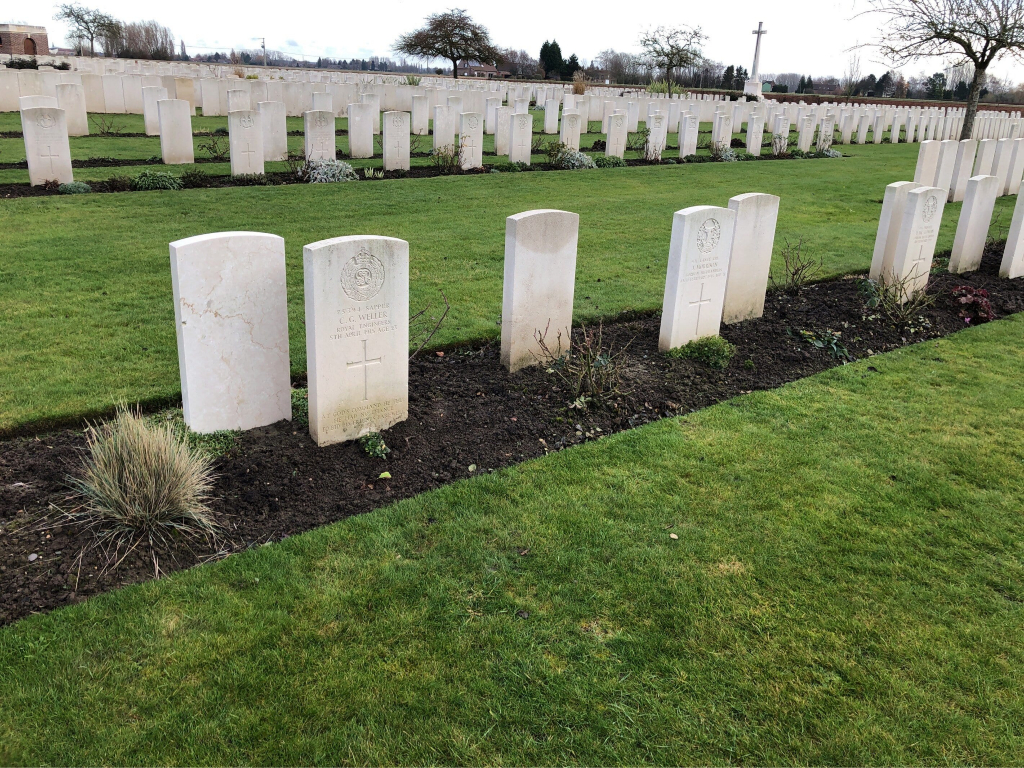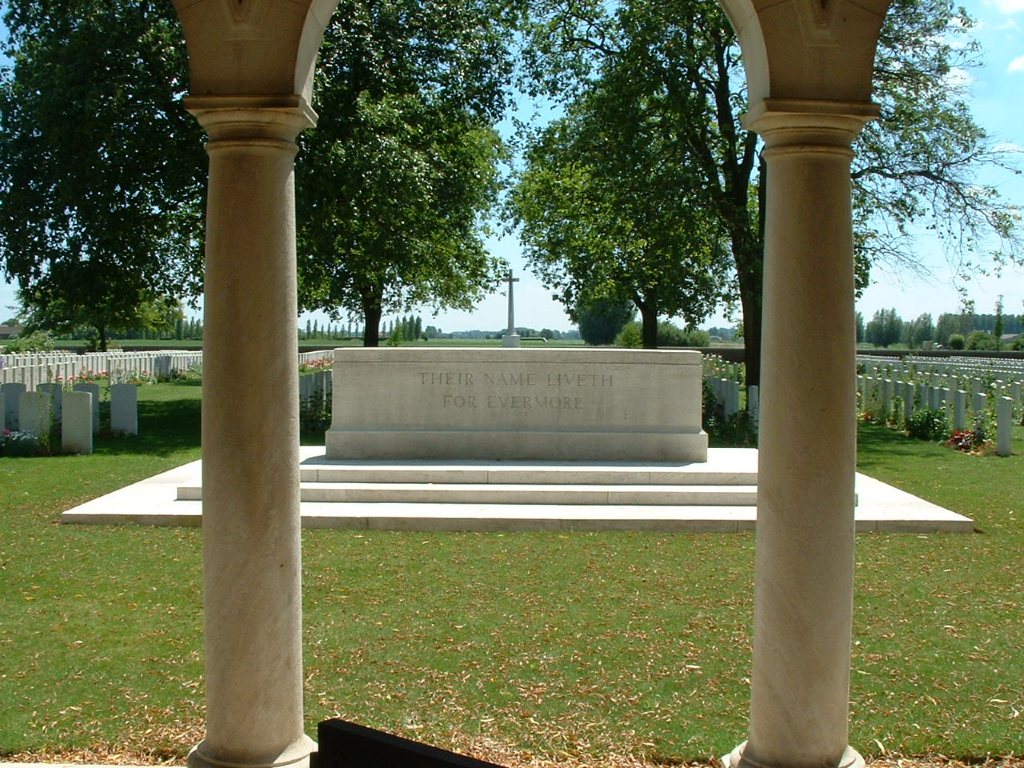Rue-Petillon Military Cemetery, Fleurbaix
- Country France
- Total identified casualties 895 Find these casualties
- Region Pas de Calais
- Identified casualties from First World War
- GPS Coordinates Latitude: 50.63134, Longitude: 2.83567
Location information
Fleurbaix is a village 5 kilometres south-west of Armentieres on the D22.
Rue-Petillon Military Cemetery will be found by taking the D175 from Fleurbaix towards Fauquissart, then the D171 towards Petillon. The cemetery is on the south side of the road from Petillon to La Boutillerie.
Visiting information
ARRIVAL
The cemetery is signposted, located on Rue du Petillon (D175).
PARKING
There is a large parking area in front of the cemetery where there are spaces for multiple vehicles.
The ground is flat and firm with a loose red gravel surface.
It is possible to park within 5 metres of the main entrance.
ACCESS LAYOUT AND MAIN ENTRANCE
At the main entrance is a triple arched memorial structure with central black, metal, mid-level, waist height decorative barriers underneath the right and left arches with a gate in the central arch.
In front of the entrance structure is stone paving, level with the gravel parking area. Three stone steps leading up to entrance arches.
The central gate section is opened by turned a loop handle clockwise, located on the top left side of the gate. The gate opens inwards into the entrance building. Paving inside the entrance building is level with the grass inside the cemetery. Access into the cemetery is through three archway openings.
There are stone bench seating areas inside the entrance building on either end with the Register Box located above the bench on the right side of the building viewed from inside the cemetery.
The Cross of Sacrifice is at the rear of the cemetery in line with the entrance and Stone of Remembrance, which is located in front of the entrance.
There are stone benches located on either side of the Cross of Sacrifice along the rear wall.
Internal paths are grass, the ground is flat.
ALTERNATIVE ACCESS
In the top-right corner of the cemetery, to the right of the main entrance is a service entrance. A 1.50-metre-wide, black metal gate latched on the left side, opens outwards. There is stone paving in the gap level with the grass on either side, providing unrestricted access onto the burial ground. The land outside the gate can be waterlogged during wet weather.
ADDITIONAL INFORMATION
The cemetery is permanently open.
History information
British soldiers began burying their fallen comrades at Rue Pétillon in December 1914 and the cemetery was used by fighting units until it fell into German hands during the Spring Offensive of 1918. The Allies recaptured this sector of the front in September 1918 and when the war ended in November the cemetery was the site of twelve Battalion burial grounds. Many of those laid to rest here had died of wounds in a dressing station that was located in the buildings adjoining the cemetery, which were known as ‘Eaton Hall’ during the war. The cemetery was enlarged in the years after the Armistice when graves were concentrated here from the battlefields around Fleurbaix and a number of smaller burial grounds. A whole range of different Commonwealth units served in this sector during the war and the cemetery contains the graves of British, Irish, Canadian, New Zealand, and Indian soldiers, as well as over 260 men who were killed while serving with the Australian Imperial Force. Today over 1,500 war dead of the First World War are buried or commemorated here.
The Australian Imperial Force – First Encounters with the Enemy
Units of the Australian Imperial Force (AIF) began arriving at the great southern port of Marseille at the end of March 1916. From there, they were transported north and, having spent a brief period in the region of Hazebrouck, were posted to the front-line trenches south of Armentières at the beginning of April. Many of these Australian soldiers had survived tough conditions and fierce fighting during the ill-fated Gallipoli campaign of 1915, but none of them had experienced combat on the Western Front.
One of their first encounters with the German forces occurred on the evening of 5 May 1916, when units of the 6th Bavarian reserve regiment raided the Australian trenches south west of Fleurbaix around Le Bridoux. After a withering artillery and mortar bombardment that caused dozens of casualties, German soldiers entered the Australian positions and captured a small number of prisoners before retiring to their own lines. For the next number of weeks, activity along this sector of the front increased as German and Australian artillery units regularly exchanged fire and German snipers claimed a steady toll of casualties.
On 30 May, the Germans staged another raid, this time attacking a salient held by the 11th Battalion AIF at Cordonnerie Farm. British and Australian miners had been tunnelling in this part of the line, and the objective of the German raid was to identify the Commonwealth regiments in the area and destroy mine shafts. At 8.15 in the evening, the Germans unleashed a devastating bombardment of artillery shells and heavy trench mortar bombs. This intense fire continued for over an hour and twenty minutes and completely destroyed the flimsy breastworks behind which the Australian troops were sheltering. Despite the noise and thick clouds of shell smoke, the men of the 11th rallied well and began firing Lewis gun rounds toward the German troops who started advancing across no man’s land just after 9.00 pm. The raiders managed to enter the Australian positions and capture a handful of prisoners, but were forced to retreat before they could inflict further damage. The lengthy bombardment that accompanied the raid on 30 May caused over 100 Australian casualties, over 40 of whom were killed. Many of those killed during the raid were buried at Rue Pétillon, which is also the final resting placing of over 100 Australian soldiers killed at the Battle of Fromelles on 19 July 1916.
The following were among the burial grounds from which Commonwealth graves were brought to this cemetery:-
BERSEE CHURCHYARD, in which three soldiers from the United Kingdom were buried in October 1918.
CUTHBERT FARM CEMETERY, RICHEBOURG-L'AVOUE, on the road from Neuve-Chapelle to Pont-Logy, contained the graves of 44 soldiers from the United Kingdom and two from India who fell in 1914-15.
DON GERMAN CEMETERY, ALLENNES-LES-MARAIS, at the Chateau-du-Bois, contained the graves of nine soldiers from the United Kingdom and one from India who fell in 1914-18.
EIGHTH CANADIANS CEMETERY, LENS, one-and-a-half miles North of the centre of Lens, contained the graves of 15 soldiers of the 8th Canadian Infantry Battalion, who fell in August 1917.
GONDECOURT COMMUNAL CEMETERY GERMAN EXTENSION, in which were buried about 650 German soldiers and ten soldiers and one airman from the United Kingdom.
HALPEGARBE GERMAN CEMETERY, ILLIES, in the hamlet of Halpegarbe, which contained the graves of eight soldiers from the United Kingdom. (There was another on the South side of the hamlet.)
HANTAY COMMUNAL CEMETERY GERMAN EXTENSION, contained the graves of one soldier from the United Kingdom and one from India.
HERRIN CHURCHYARD AND GERMAN EXTENSION, the Germans buried five soldiers from the United Kingdom in the Churchyard in 1915 and two in the Extension in 1918.
ILLIES CHURCHYARD, where the Germans buried one soldier from the United Kingdom in 1914.
LA BASSEE COMMUNAL CEMETERY GERMAN EXTENSION, used by the Germans for the burial of seven soldiers from the United Kingdom and by the 55th (West Lancashire) Division in October 1918, for the burial of 29 of their men.
LAMBERSART COMMUNAL CEMETERY GERMAN EXTENSION, which contained the graves of 1,016 German soldiers, 32 soldiers and airmen from the United Kingdom and two soldiers from Australia; and LAMBERSART GERMAN CEMETERY, a cemetery of 5,045 burials on the North-West side of the village.
LE PETIT MORTIER GERMAN CEMETERY, STEENWERCK, which contained the graves of 86 German soldiers and three from the United Kingdom.
MERRIS CONVENT GERMAN CEMETERY, in which one Australian soldier was buried in May 1918.
RUE MASSELOT (2nd LINCOLNS) CEMETERY, LAVENTIE, half-a-mile North of Fauquissart, where 54 soldiers from the United Kingdom including 37 of the 2nd Lincolns were buried in 1915 and 1918 in an orchard. In May-August 1918, the Germans made two considerable cemeteries (now removed), almost surrounding it.
SALOME CHURCHYARD GERMAN EXTENSION, contained the grave of an officer of the H.L.I. The German graves were initially taken to SALOME COMMUNAL CEMETERY GERMAN EXTENSION, from which twelve British graves were removed to Rue-Petillon.
VERLINGHEM CHURCHYARD GERMAN EXTENSION, contained the graves of three British soldiers.
WERVICQ-SUD GERMAN CEMETERY, on the road to Le Blaton, where 23 soldiers from the United Kingdom were buried in November 1914 and April 1918; five graves were removed to Rue-Petillon and 18 to Messines Ridge British Cemetery.



